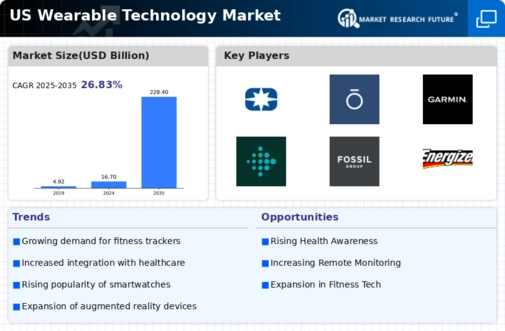Focus on Personalization
The growing emphasis on personalized experiences is shaping the wearable technology market. Consumers are seeking devices that not only meet their functional needs but also reflect their individual preferences and lifestyles. This trend has led to the development of customizable wearables, allowing users to select features, designs, and functionalities that suit their unique requirements. In 2025, the wearable technology market is expected to see a rise in sales of personalized devices, with estimates suggesting that around 40% of consumers will prioritize customization options. This focus on personalization is likely to enhance user engagement and satisfaction, further driving market growth.
Technological Advancements
Rapid advancements in technology are significantly influencing the wearable technology market. Innovations in sensors, battery life, and connectivity options have led to the development of more efficient and user-friendly devices. For instance, the integration of artificial intelligence and machine learning into wearables allows for personalized health insights and predictive analytics. In 2025, the wearable technology market is expected to witness a compound annual growth rate (CAGR) of around 15%, largely attributed to these technological enhancements. As companies invest in research and development, the introduction of new features and functionalities is likely to attract a broader consumer base, thereby propelling the market forward.
Rising Health Consciousness
The increasing awareness of health and wellness among consumers is a pivotal driver for the wearable technology market. As individuals prioritize fitness and preventive healthcare, the demand for devices that monitor health metrics has surged. In the US, the wearable technology market is projected to reach approximately $60 billion by 2025, driven by consumers seeking to track their physical activity, heart rate, and sleep patterns. This trend is further fueled by the proliferation of fitness apps and social media platforms that encourage sharing health achievements. Consequently, manufacturers are innovating to create more sophisticated devices that cater to this health-conscious demographic, thereby expanding the wearable technology market.
Consumer Demand for Connectivity
The desire for seamless connectivity among devices is a significant factor propelling the wearable technology market. As consumers increasingly rely on interconnected ecosystems, wearables that integrate with smartphones, smart home devices, and other technologies are in high demand. This trend is evident in the rise of smartwatches and fitness trackers that offer notifications, music control, and compatibility with various applications. By 2025, it is projected that over 50% of wearable technology market sales will be attributed to devices with advanced connectivity features. This consumer preference for integrated solutions is likely to drive innovation and competition among manufacturers.
Increased Adoption in Healthcare
The healthcare sector's growing acceptance of wearable technology is a crucial driver for the market. Medical professionals are increasingly utilizing wearables for remote patient monitoring, chronic disease management, and post-operative care. This trend is supported by the US government's initiatives to promote telehealth and digital health solutions. By 2025, the wearable technology market is anticipated to see a substantial increase in healthcare-related applications, with an estimated 30% of devices being used in clinical settings. This shift not only enhances patient outcomes but also reduces healthcare costs, making wearables an integral part of modern healthcare strategies.























Leave a Comment